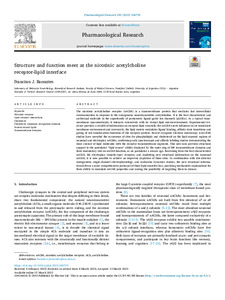Por favor, use este identificador para citar o enlazar este ítem:
https://repositorio.uca.edu.ar/handle/123456789/16473| Campo DC | Valor | Lengua/Idioma |
|---|---|---|
| dc.contributor.author | Barrantes, Francisco José | es |
| dc.date.accessioned | 2023-06-06T10:38:24Z | - |
| dc.date.available | 2023-06-06T10:38:24Z | - |
| dc.date.issued | 2023 | - |
| dc.identifier.citation | Barrantes, F. J. Structure and function meet at the nicotinic acetylcholine receptor-lipid interface [en línea]. Pharmacological Research. 2023 (190). doi: 10.1016/j.phrs.2023.106729. Disponible en: https://repositorio.uca.edu.ar/handle/123456789/16473 | es |
| dc.identifier.issn | 1096-1186 (online) | - |
| dc.identifier.uri | https://repositorio.uca.edu.ar/handle/123456789/16473 | - |
| dc.description.abstract | Abstract: The nicotinic acetylcholine receptor (nAChR) is a transmembrane protein that mediates fast intercellular communication in response to the endogenous neurotransmitter acetylcholine. It is the best characterized and archetypal molecule in the superfamily of pentameric ligand-gated ion channels (pLGICs). As a typical transmembrane macromolecule, it interacts extensively with its vicinal lipid microenvironment. Experimental evidence provides a wealth of information on receptor-lipid crosstalk: the nAChR exerts influence on its immediate membrane environment and conversely, the lipid moiety modulates ligand binding, affinity state transitions and gating of ion translocation functions of the receptor protein. Recent cryogenic electron microscopy (cryo-EM) studies have unveiled the occurrence of sites for phospholipids and cholesterol on the lipid-exposed regions of neuronal and electroplax nAChRs, confirming early spectroscopic and affinity labeling studies demonstrating the close contact of lipid molecules with the receptor transmembrane segments. This new data provides structural support to the postulated “lipid sensor” ability displayed by the outer ring of M4 transmembrane domains and their modulatory role on nAChR function, as we postulated a decade ago. Borrowing from the best characterized nAChR, the electroplax (muscle-type) receptor, and exploiting new structural information on the neuronal nAChR, it is now possible to achieve an improved depiction of these sites. In combination with site-directed mutagenesis, single-channel electrophysiology, and molecular dynamics studies, the new structural information delivers a more comprehensive portrayal of these lipid-sensitive loci, providing mechanistic explanations for their ability to modulate nAChR properties and raising the possibility of targetting them in disease. | es |
| dc.format | application/pdf | es |
| dc.language.iso | eng | es |
| dc.publisher | Elsevier | es |
| dc.rights | Acceso abierto | * |
| dc.rights.uri | http://creativecommons.org/licenses/by-nc-sa/4.0/ | * |
| dc.source | Pharmacological Research Vol.190, 2023 | es |
| dc.subject | RECEPTOR NICOTINICO DE ACETILCOLINA | es |
| dc.subject | COLESTEROL | es |
| dc.subject | LIPIDOS PROTEICOS VECINALES | es |
| dc.subject | DOMINIOS TRANSMEMBRANA | es |
| dc.subject | INTERACCIONES LIPIDO-RECEPTOR | es |
| dc.title | Structure and function meet at the nicotinic acetylcholine receptor-lipid interface | es |
| dc.type | Artículo | es |
| dc.identifier.doi | 10.1016/j.phrs.2023.106729 | - |
| dc.identifier.pmid | 36931540 | - |
| uca.disciplina | MEDICINA | es |
| uca.issnrd | 1 | es |
| uca.affiliation | Fil: Barrantes, Francisco José. Pontificia Universidad Católica Argentina. Instituto de Investigaciones Biomédicas. Laboratorio de Neurobiología Molecular; Argentina | es |
| uca.affiliation | Fil: Barrantes, Francisco José. Consejo Nacional de Investigaciones Científicas y Técnicas de Argentina; Argentina | es |
| uca.version | publishedVersion | es |
| item.grantfulltext | open | - |
| item.languageiso639-1 | en | - |
| item.fulltext | With Fulltext | - |
| crisitem.author.dept | Instituto de Investigaciones Biomédicas - BIOMED | - |
| crisitem.author.dept | Laboratorio de Neurobiología Molecular | - |
| crisitem.author.dept | Facultad de Ciencias Médicas | - |
| crisitem.author.orcid | 0000-0002-4745-681X | - |
| crisitem.author.parentorg | Facultad de Ciencias Médicas | - |
| crisitem.author.parentorg | Instituto de Investigaciones Biomédicas - BIOMED | - |
| crisitem.author.parentorg | Pontificia Universidad Católica Argentina | - |
| Aparece en las colecciones: | Artículos | |
Ficheros en este ítem:
| Fichero | Descripción | Tamaño | Formato | |
|---|---|---|---|---|
| structure-function-meet-nicotinic.pdf | 3,46 MB | Adobe PDF |  Visualizar/Abrir |
Visualizaciones de página(s)
46
comprobado en 27-abr-2024
Descarga(s)
100
comprobado en 27-abr-2024
Google ScholarTM
Ver en Google Scholar
Altmetric
Altmetric
Este ítem está sujeto a una Licencia Creative Commons

